|

Grasses, dried in autumn.
(*photo credit)
November 1, 2010 Do We
Make Informed Food Choices?
If
we look deeply, we discover that choice can be evasive. My 1970s national
public interest decade proved a time that this was so. If we remain uncritical
and follow the company line, we allow advertising to overwhelm us no matter what
the item. What applies when I talk about heavy enticement in Tobacco Days
can also be applied with qualification to purchase of commercial foods.
We
are programmed to change diets more than we think throughout life. Children's
food is not the adults'; we were weaned from mother's milk and infant formula;
we accepted and engaged in school lunch programs; we graduated to fast foods and
diet foods and barbecues cooked by friends and confreres. Few have rigid
lifetime diets; most shift to more available and enticing foods. We eat faster
and we consume fewer relaxed meals; we buy imported and out-of-season foods once
slated for festive occasions; we deny that we are eating too much of the wrong
thing. Our diets direct us, not the other way around, for food-eating practices
and smoking habits have profound similarities. Unless fully aware, we tend to
become strongly influenced in food choices, despite knowing that food is
essential and smoking is a form of entertainment. Food habits can also tend to
be addictive and life-threatening.
As
a people, are we moving in the direction of resource-costly prepared frozen
dinners, snacks, soft drinks and food dishes, or are we still able to cook with
basic ingredients even though they take more time to turn into meals? Do we as
Americans note that our diets are based on time availability, locations, foods
at hand, and peer pressures -- not on what is grown on our farmstead this year?
We develop new tastes, but what causes this? Often income is a greater
determinant than health issues in diet change. As tens of millions of Chinese
advance to more disposable income, they "acquire" a taste for more expensive and
resource-intensive foods; rice and legumes are replaced by meat, eggs, and dairy
products along with specialty fruits and prepared meals and snacks-- thereby
causing changes in land use and resource distribution.
Modern
supermarket foods entice us, as we walk the long air-conditioned aisles filled
with choices. We buy from our list, and then personal impulse adds this or that
to the shopping basket. Yes, we are doing what is induced by container
appearance: color, shape, logo, etc. Resolution to buy only needed items has
been broken and the labels are passed over. Over the decades CSPI has
championed more informative labels, some have not liked the agency's successful
campaign to apply warning labels to wine. Eventually some labels ARE read.
When eating we may pick up and read the labeled container stating ingredients or
calorie contents. The government has established requirements to check false
and extravagant claims. And the consumer is in agreement.
An answer: No, we
do not make totally informed food choices but we ought to. Opportunities exist
to do so.

Mums to brighten an autumn day.
(*photo credit)
November 2, 2010
Should Emphasis Be on Growing Food?
The
conscientious consumer demands good food safeguards for what is purchased and
consumed. Often in the early days, CSPI straddled the consumer and the
environmental movements -- and discovered that good consumerism is good
environmentalism. However, there is another ingredient that composes the
three-legged stool of food, namely local origin of foods. Consumers want their
money's worth and that means high quality, chemical-free, properly weighted,
well-labeled food materials. The focus on good nutrition is part of that
high-quality purchase and consumption but not the whole picture.
The
environmentally-concerned involve themselves in food issues as well. These
citizens prefer foods that are not shipped from great distances (shipping
demands transport energy and refrigeration in order to keep the produce fresh).
For them, local food sources become a prized consumer focus and do not demand as
many food safety inspections because the origin can be easily checked. The
environmentalist is more focused on resource conservation in the cultivating,
processing and delivering of food. The activist consumer may demand serviceable
individualized packaging for protection and verification in purchase as to
quality control; the environmentalist may be interested in keeping the packaging
of a type that requires fewer resources in production (plastic versus paper or
bring-your-own containers). Furthermore, one can pick up loose produce and put
it directly into one's own tote bag.
Food
purchasers have different concerns from those of food growers. The more astute
food purchasing advocates turn attention to pressuring the Federal Trade
Commission with demands for truth in advertising and in local and more
comprehensive food safety requirements. "We become what we PURCHASE and eat."
On the other hand, growers are concerned about production economics, physical
exercise, weather, water sources, local individual controls, and spiritual
enhancement through communion with soil and plant life. "We become what we GROW
and eat." In part, my move back to the hills of Appalachia from urban DC in
1977 was because the simple lifestyle techniques highlighted in 99 Ways to a
Simple Lifestyle needed to be verified -- and gardening was a major
component. Certainly rural folks need food safeguards and consumer protection
for they are also subject to massive infusions of junk foods; but growing one's
food in congested urban areas was difficult.
An
answer: If you have time, space and energy, use them well and grow your own
food. Virtually all of us are purchasers needing to exercise consumer caution,
but we can also be growers. If too old, or ill, or young, or busy, then
moderate the extent of growing. If able, then be both a grower and a purchaser
in ways that allow for growing herbs, salad greens, and root crops well into
autumn. Limit purchase to foods not easily grown in limited space. In buying,
recall caveats made in the previous essay; be discerning as to quality and
price, and patronize local growers.
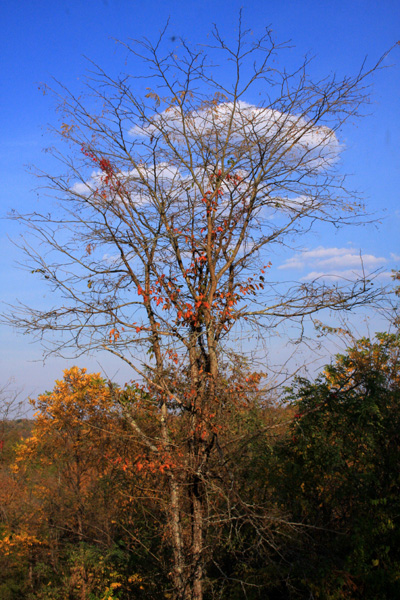
Brightly colored red and gold against blue sky.
(*photo credit)
November 3, 2010
Have We Calculated All Food Energy?
We
can talk about the energy content of food in two ways: the internal
energy or the amount of calories that can be obtained by digesting certain
foods; and the amount of external energy it takes to grow, process,
transport and preserve the food.
With
reference to the first, we could focus on "empty calories" to be avoided by
those with weight problems; we could also focus on the needed, rich-calorie
foods needed by famished workers or trail hikers who need extra energy.
With
reference to external energy factors, we search about and find non-renewable
energy inputs in many often hidden places. We may want to stop or to continue
searching for energy factors such as advertising and promotion, or land
fertilization or preparation for crop-growing. We tend to neglect these more
hidden factors, depending on whether we want to prove more or less energy use:
energy in crop growth
and tillage and harvesting;
energy to transport
produce to processing centers;
energy in agricultural
waste disposal;
energy in processing the
raw materials;
energy in manufacturing
food containers;
energy in transporting
foods from place to place;
energy in commercial
storage, refrigeration, and lighting;
energy in bringing foods
to the kitchen;
energy to refrigerate
and store along with added
external energy to
dispose of wasted food;
energy it takes to
prepare the food for the meal; and
energy to wash utensils
and dishes.
Let's take two cases; in one we want to air-ship raw grapes from South America
to our regional distributing center; these are transported by refrigerated truck
to the grocery and there they are refrigerated and a certain percentage sold and
not tossed. We go by automobile and purchase the raw grapes, take them home,
and decide to eat them as a nutritious dessert or for snacks. We note this
unprocessed food has a considerable external food energy input. In contrast, we
eat only seasonally-grown local grapes that occur in August up to and into early
autumn. We go out, pick, and eat them right there. Virtually no external
energy is needed and yet the same nutrition may exist (provided neither example
is treated with pesticides).
An
answer: Attributing external energy is a complex and somewhat difficult
task. Have we included the governmental security factors in bringing foods into
this country or the costs of safety procedures? However, granting the limits of
what is accounted for, there is some value in comparing different methods for
obtaining a desired food product. The thrust for transparency will make us more
likely to include energy expenditures that others would prefer to overlook. The
exercise is not precise but can help raise levels of food/energy/environmental
consciousness.
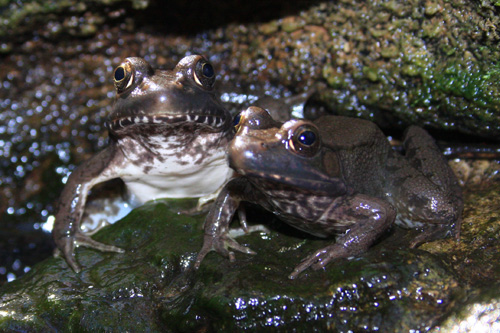
Friends. (Green frog, Rana clamitans).
(*photo credit)
November 4, 2010
Do We have to Go Organic?
A
mounting effort is being made today to grow, certify, classify and purchase
"organic foods," a fast-growing segment of the total food economy. Organic
foods are those free from commercially-synthesized pesticides and fertilizers as
well as other medicinal, growth-enhancing, and commercially-available chemical
substances. The buzz word is "natural," and so organic evolved beyond the
subject matter of our organic chemistry field. In the world of chemists,
"organic" meant naturally-derived chemicals, but through human-induced synthesis
came to include all carbonaceous compounds synthesized from coal tar or
petroleum into carbon-derived materials. My tradition as a synthetic organic
chemist included being thrilled to make new products whether useful or not, and
mine were not naturally-derived organic chemicals -- they came from the most
part from fossil fuel derived chemicals. For food purists "organic" means
non-synthesized and challenges synthetic organic chemists. This is not always
understood.
Fertilizers
termed "organic" are the most difficult for chemists to accept. All admit that
overuse of concentrated synthetic fertilizers has contaminated water systems
through runoff and caused unnatural growth patterns among crops. For the life
of me, I have to favor some basic "synthetic" fertilizers even though their
overuse is quite harmful. My own fertilizing materials include not only my
kitchen compost, but also my diluted urine on occasion, and certain wood ashes
and mature horse manure. However, although I do not buy commercial fertilizers
that are anathema to some, neither do I condemn them. My choice is because I am
cheap, not because I am theoretically opposed to their proper use. Use
commercial fertilizers when you need to, but use them sparingly.
Pesticides
that are synthetic rightly alarm many gardeners. I recall hired hands on our
tobacco farm would get sick from applying a lead arsenate, "Paris Green," (an
inorganic chemical) on hot, muggy summer days. On the farm we also applied
potent pesticides to beans and potatoes; however, in the years since, I have
refrained from such applications for the sake of the agent and others who would
handle and consume the plants. My professional gardener, great uncle told about
a spray plane flying over his field and playfully spraying his field workers --
and one got very sick. Powerful pesticides are no laughing matter. Not all
pesticides wash off easily or disappear quickly. I refrain from such pesticides
and let a few pests take their toll. Try growing companion plants that are
very attractive to Japanese beetles (evening primrose) and higher on the pecking
order than grape leaves and beans. Marigolds discourage certain pests.
An
answer: Use as few commercial chemicals as possible whether as medicine or
in your home, garden, lawn or orchard. Absolutely "organic" is difficult to
attain, retain, and sustain today because contaminating chemicals are persistent
and becoming somewhat ubiquitous. If organic certification is too painstaking
and costly, do the best to reduce the use of commercial chemicals.

A once-productive henhouse.
(*photo credit)
November 5, 2010
Are We Overly Concerned about Food Nutrition?
Can
one overdose on "nutritional supplements?" I watched in horror as a friend took
his daily massive handful of vitamins and nutritional compounds at his breakfast
table. He obtained all this assortment of freebies from a health center where
his wife works. Maybe each item is good in its own right, but what on earth
does such a combination do to the human being when metabolized simultaneously?
Isn't this a form of overdosing? Isn't a combination of too many good things
possibly a bad thing?
A
few people grow up in a household that sets ordinary food before them and they
are grateful -- and eat it. Another portion of eaters are more picky; they
dictate what they like, and their diets could involve too much meat, fat or
sugar. Nutritional balance is harder for them to establish. Some live totally
healthy lives through balanced eating and never taking supplements and extra
vitamins. In other cases, people lack certain basic ingredients and, upon
proper diagnosis, their doctors prescribe particular supplements. In other cases
friends do the prescribing. Nutrition applies to everyone but in different
ways.
People are willing to
invest in what they term good foods (fruit, vegetables, nuts, whole grains,
etc.) and omit what they call bad (excess salt, refined sugar and fat). They
will think it good to eat strawberries that they know are loaded with Vitamin C,
and yet forget they are loaded with pesticides to help them stay plump and fresh
when being shipped from a foreign country in mid-winter. When we construct a
three-legged stool of local food, economic food, and nutritious food, we must
consider energy expenditures in air-shipping strawberries. If we neglect the
other two components (namely price and local growing), nutrition concerns can
get out of kilter. Choosing to consume nutritious foods, locally-grown in
season, is healthy for us and Earth; choosing to pay high prices for imported
out-of-season nutritious foods is not.
Let's
always champion balanced nutrition. Generally a healthy diet goes along with
healthy physical exercise, and this allows for more sugar, fat or salt when
these can be burnt off and eliminated in the form of sweat. Thus balanced body
exercise allows a greater variety than nutritionally-concerned "foodies" permit
in their kitchens. Let's honor the attempt to refrain from eating out-of-season
food that is not grown in a local greenhouse or protected garden, or preserved
as frozen, or canned, or dried, or pickled, or stored in a root cellar.
An
answer: It is possible for some to become overly concerned about many
things, including personal health. We ought to uphold and honor balanced
nutrition at all times, as worthy of consideration along with food economy and
local food sources. We need to live simply and not follow the affluent
overconcern about every detail of life, for that can devolve into selfishness.
Let's affirm a concern about a plentiful supply of good nutritious food for our
immediate and our entire global family.

Berries of the flowering dogwood, Cornus florida.
(*photo credit)
November 6, 2010
Is Food an Instrument of Resolution?
While
residing in Washington, DC, I became personally acquainted with Esther Peterson
(1906-1997), who was the Special Assistant for Consumer Affairs under the
Johnson and Carter administrations, and later president of the National
Consumers League. In that period, Esther was a vice president of Giant Foods
and an advisor to our CSPI on food issues. I was always ambivalent about
"consumerism," for it did not always include a balanced environmental
component. In one meeting with Esther, I expressed my anti-nuclear energy
concerns; she said she wanted to get me together with her pro-nuke
acquaintances, and she was willing to invite us all to a good home-cooked
spaghetti meal to hash this whole issue out. Now to me that was a Washington
approach, mixing my-mother's-home-cooking-solves-problems philosophy with a
major global issue. Yes, a home-cooked meal sounded great, but I told Esther
that although while tempting, I doubted that it could resolve matters.
Something far more fundamental was at stake.
We need not deny the power
of partaking meals together. Jay Womik in The Great Upheaval: America and
the Birth of the Modern World 1788-1800 writes about "the most famous dinner
in American history (p. 163). On June 20, 1790, Thomas Jefferson, who knew how
to entertain with good food and wine, invited James Madison and Alexander
Hamilton to his house and they hammered out a compromise; this was to have the
states' Revolutionary War debts assumed by the federal government; at the same
it would placate Virginia by proposing that the Federal District be placed on
the Potomac River between that state and Maryland. Simple compromise worked
there but it does not always work. Where fundamentals are at stake,
orchestrated meals may only define differences. Meals may resolve personal
matters, but rarely do they have the same success as that one in 1790.
Ralph
Nader told his raiders never to take even a cup of coffee from someone with whom
we have fundamental differences. I regret that I took a cup of coffee from an
oil company executive once and then refrained from bringing up a matter of the
company's pollution problems. Washington, DC, is a charged place, one where all
are in general agreement about the need for government, and so conviviality
through food and drink is one way of coming to compromise. But are all
potential compromises equal, especially when one side has far more political or
economic power than another? Sharing food is necessary when people are hungry;
it is not necessarily desirable if an issue in question deserves formal debate.
Food can help resolve personal issues; that is not so in all political and
economic problem areas where compromise means capitulation to the stronger side
-- who pays for the meal.
An
answer: Let's not devalue the power of a good meal together, for many times
differences can be defined or worked through. Sharing food has its place, but
we ask whether each and every difference ought to be resolved by eating
together. Some demand public debate away from a dining atmosphere.

Colors of the faded Eastern redbud, Cercis canadensis.
(*photo credit)
November 7, 2010
Homily: God of the Living?
God
is not the God of the dead but of the living. (Luke 20:38)
I wrote the first draft of
this homily in mid-summer while at breakfast. I was eating to my heart's
content and National Public Radio was giving a press report; it was announcing
that eight million, or half of Niger's population, was threatened with
starvation. Was I so calloused as to continue without some thought of brothers
and sisters on another continent who did not have enough to keep them alive?
The report added that the food supplies were sufficient to give high protein
supplements to those under the age of two. This triage of food supplies meant
that the three-year-olds were condemned to the terror of hunger.
Let's
remember that hunger is a form of terror, though never defined as such by the
well-fed. Our nation was spending one billion dollars a day fighting terrorism
in a military way on another continent. Something is wrong if we also hold that
ALL are alive for God, and gentle ways could also reduce terrorism. How are we
to judge a dispersal of world resources so that our supposed security and
welfare are ensured militarily through exercises that endanger the lives of
others? We show in our actions that God is truly with us -- and we do this by
ensuring life for all in the human family, for to be "for God" means being for
people.
Some
may say, "Let's be practical." We can only focus on so much security at one
time, and some of the armed ones will be sacrificed in the process. Yes, I am
attempting to be practical in this month of food concerns. Being practical in
the most elementary sense is furnishing basics to those most in need -- and this
has a higher priority than killing terrorists in the mountains of Afghanistan
and Pakistan. Terror comes in many forms, and we cannot look to eliminating one
while allowing an equally and more far-reaching variety to go unchallenged and
unchecked. World hunger is a global AND a terrorist issue. We need to see
this.
World
hunger could be eliminated with only a fraction of the one-and-a-half trillion
dollars spent each year on military forms of security -- and this could be the
greatest form of global security in itself. In Caritas in Veritate, Pope
Benedict XVI calls for an elimination of world hunger because it is an ethical
imperative of the Church, and also because this has become a requirement for the
peace and stability of our world. Actually we could work together in collective
citizenship and change the politics of world hunger. Consider obtaining and
discussing the new book by David Beckmann, Exodus from Hunger (Westminister:
John Knox, October, 2010). Also contact "Bread for the World, "<www.bread.org>
for "What You Can Do to End Hunger."
Prayer
for the week: Lord help us to see that our human efforts can make an
immense difference, if we but work together to alleviate the urgent problems of
world hunger.
Introduction to 1980s:
Food as Humanly Touched
With sweat on your brow
shall you eat your bread...(Gen. 3:19)
I returned from Washington,
DC, to Appalachia in 1977. My firm resolution (with the encouragement of my
Jesuit superiors) was to apply the suggestions made in our recent CSPI book,
99 Ways to a Simple Lifestyle (Anchor Press, 1976 and University of Indiana
Press, 1978). Chapter III of that book dealt with fourteen food topics (e.g.,
Eat Less Meat, Eat Wild Foods. etc.) and Chapter IV treated seven more (Garden
on Available Land, etc.). Thus the hopes for the new Appalachian center
(Appalachia -- Science in the Public Interest) included a local food production
element.
Though
I was born on a farm, still by 1977 it had been two decades since I had
seriously gardened. New concerns such as use of pesticides and tillage methods
had emerged. The challenge went further than past practices; space on which to
grow vegetables is more limited in Appalachia. Time for us to devote to
gardening had to be planned with greater care, since the work of operating an
appropriate technology demonstration center was all consuming.
Before leaving DC, I had already
been committed to making a garden a basic focal point of my diet. Our small
Jesuit community that lived at the Franciscan Shrine grounds in north
Washington, had access to a large lawn. We obtained permission to use part of
that space for some small-scale gardening. We were becoming convinced that
locally-grown food tastes better when mixed with one's own sweat and the touch
of one's own hands and heart.
With
time one looks for deeper reasons for gardening. A higher quality of life is
available somewhere on the continuous resource-expenditure-range from
destitution to overabundance -- and what constitutes sufficiency for different
individuals can be found over a broad zone. Obtaining those resources in that
middle range can occur through gardening and growing what one eats. This
gardening can be so engrossing that public interest work can be overlooked or
relegated to others. Balance must be retained.
Upon
establishing ASPI we discovered that voluntary lifestyle change without some
governmental regulation is virtually impossible in our crassly materialistic
culture. The middle course calls for voluntary change along with willing
cooperation among democratic people so that the food commons may be reclaimed by
all.
A
more troubling question is whether people can undertake the middle course, if
addicted to materialistic consumption. Can they voluntarily come to a
simplicity under certain conditions, especially if they are among the great
majority of Americans bombarded by advertisements to buy, get a credit card,
gamble and, as leaders say, "consume"? Addictions in food-related matters cloud
good judgment. Do we excuse the over-consumption as a person's private matter?
Should we regulate excessive lifestyle and apply anti-drug campaigns into areas
of excessive food intake?
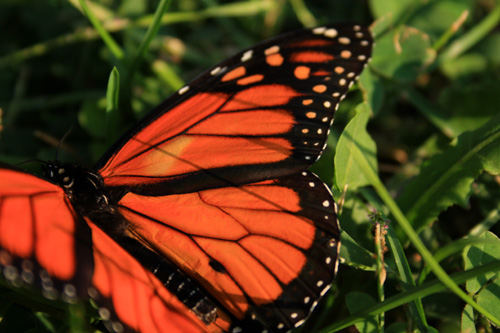
A late-migrating monarch.
(*photo credit)
November 8, 2010
Is Simplicity in Gardening Easy to Teach?
In
the 1980s, I began to take gardening seriously. This involved doing my own
thing, since it took too much time supervising the inexperienced. I wrestled
with how much time it takes to teach gardening; it involves more than
distributing tools and saying, "Go to work." An inexperienced gardener cannot
tell a weed from a useful plant, how close to hoe without disturbing a root
system, what to mulch, or the importance of not tramping in the growing area.
Even the time of day is a matter of when to work in the garden. The general
consensus that everyone can garden needs some distinctions: everyone should
garden; everyone has something to learn from others who have gardened in the
past.
Gardening economics is a driving force behind growing your own produce. In
fact, the other advantages of gardening such as physical exercise and resource
conservation (no transportation costs) can help multiply the dollar-and-cents
savings beyond mere calculations of savings per hour spent. Small plots will
not be spacious enough to feed families who want to satisfy bulk needs such as
corn; however such plots can go a long way to satisfying the desire for certain
higher-priced specialty items that are highly nutritious, but beyond the normal
shopping list. Where more land is available, the grower may opt for
lower-priced crops such as potatoes or cabbage. When the land is still more
spacious, one can consider pumpkins, watermelons, sunflowers, and sweet corn.
The
human touch is of utter importance; we must touch the soil in which we
receive nutrition and life. We bless the land when we touch it and work with it
to our benefit. Our over-indulging consumer culture suffers from a disease that
some term "Affluenza." Just as destitution is undesirable, over-abundance at
the other end of the consumption spectrum has its negative effects as well. A
happy middle ground is the space in which material goods are not too scarce nor
too abundant. When speaking of food, appropriate "use" means moderating the
amount of intensive-resource foods and choosing less resource-intensive, simpler
foods. Many in this world suffer from near destitution and a billion go
to bed hungry.
The United Nations estimates
that one hundred million people are in danger of lapsing into destitution for
lack of food; an additional billion people lack decent affordable housing and
safe drinking water. On the other end of the resource spectrum, a privileged
few overuse resources. Yes, lack of communal health includes global destitution
and over-consumption of resources including excessive amounts of resource-rich
food (meat and processed foods). Overconsumption of resources leads to group
insecurity and overstress on maintaining possessions: vehicles, electronics,
houses. Maintenance of resources takes time.
An
answer: A willing gardener is open to learning at all times, and besides
basic gardening technique we all must learn what can be grown optimally on the
garden space available. The practice can also lead to simplifying one's
lifestyle.

Rain barrel to store and supply water for small garden plot.
(*photo credit)
November 9, 2010
Locally-Grown: Are We What We Eat?
There
are a series of reasons for locally grown foods. If we are what we eat, then
let's be local:
1. Spirituality:
Natural growth processes generate rhythms of the soul. We are spiritually
uplifted in growing our own food.
2. Resources: Energy
savings result from raising home-grown produce in contrast to factory-farming
and transporting food.
3. Personal Control:
Gardening allows households to avoid contaminants on produce and to ensure the
safety of their foods through organic processes.
4. Environment:
Eating local produce helps avoid damaging land fertility and the environment,
provided good practices are used.
5. Labor Practices:
Home growers have better control of labor practices at all stages of food
production and preparation. Consider the exploitation of migrant farm workers,
who are often expected to work without adequate protection against agricultural
poisons and without proper housing conditions.
6. Aesthetics: Let's
beautify the countryside. Construct the garden landscape artistically through
the choice of plants, the timing of maturation and the careful placement of each
vegetable.
7. Eco-justice: Make
a powerful political statement of social justice/eco-justice through gardening.
We will not buy products unless we are sure that workers receive a just wage.
8. Health: Obvious
health benefits occur to all including older people who get outside exercise and
fresh air when gardening. A sense of well-being and control over one's life
comes from self-sustenance and result in improved health.
9. Savings: Economic
benefits result from growing one's own nutritious foods and sharing them with
others in the vicinity. We are experiencing rapidly inflating food prices. At
a time of inflated food prices, savings accrue by growing one's own food.
10. Psychology: In
growing our own food we can take control over our own lives and gain an added
measure of self-respect. We provide for ourselves and break the total
dependence on others for our food needs -- and this encourages us to take other
actions.
11. Model: We show
others in the local area what they can do to become self-sustaining through
gardening. People tend to imitate those who are neighbors and find that
learning about gardening is less threatening if teachers are familiar to them.
An
answer: Yes, we are what we eat, so let's remain local to the greatest
degree possible.
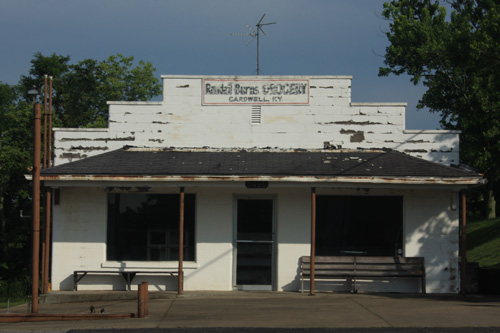
Small town market, Cardwell, KY.
(*photo credit)
November 10, 2010
Is Knowing the Food Source a Control on Quality?
If we choose locally-grown
food, we have a better chance of knowing the source and deciding whether what is
grown is good for us. Difficulties arise when we want our food to come from
indeterminate places. Local farmers' markets allow the interaction of grower
and consumer. However, while growing one's own is better than just knowing the
growing and marketing conditions, sometimes the latter is the best we can do.
Some cannot be growers; the elderly or ill do not have the capability, nor do
the very young, or the overly busy, who do not have sufficient time to do much
of anything but work and snatch times for eating and sleeping.
Today,
those of us with the energy to grow things ought to strive for "Freedom
Gardens," that is, gardens free from corporate control of our eating materials.
These are equivalent to the "victory gardens" of the Second World War. These
freedom gardens can supply plentiful, nutritious, low-cost food so that we can
free up mass-produced crops -- grains, root crops, and edible oil-bearing crops
-- for export. The freedom gardener gains many benefits: physical, spiritual,
social and economical -- and a different way of seeing life in which we have a
part to play.
Much
urban land is now in lawn, which consumes about one-seventh of our
energy-intensive fertilizer plus the fuel needed by motorized lawn-care
instruments (it takes less non-renewable energy to cultivate gardens than to
manicure lawns). The locally-grown produce requires no transport energy;
neighbors who are gently prodded to do similar things and, through community
give-and-take, can overcome the natural embarrassment of being inexperienced;
and the garden can become a beautiful and diversified landscape that stands in
contrast to monolithic lawns.
The
major advantage of locally-grown food, especially grown on once-prime
farmland-turned-suburban-residence, should not be overlooked. Many
concerned environmentally-conscious people talk about "farming on the edge" and
mean the encroachment of development on otherwise large tracts of farmland in
every state of our country with expanding metropolitan areas through suburban
sprawl. One can grow produce around or above buildings (roofs). New-found
garden space is all about and can extend seasonally through cold frames, berming,
and greenhouses. Upon virtually any urban survey, one can discover vacant urban
areas that could be converted to community gardens for those short of growing
space. With changes in attitudes about food, people come to prefer more
locally-grown food while out-of-season foods appeal to the affluent, thanks to
rapid air-shipping and refrigeration. However, the carbon footprint is
horrible, and possible pesticides go undetected, all for the sake of the perfect
appearance. All able-bodied citizens ought to aspire to be food producers. Is
that too much to ask of our countrymen and women?
An
answer: Desiring to choose locally-grown foods means we ought to know the
sources of the food materials.

Home-grown shiitake mushroom, harvested after brisk autumn rain.
(*photo credit)
November 11, 2010 Is
Having Fresh Produce Better-Quality Living?
The tripod of good gardening
is good fresh quality, nutritional content, and productive yields. The fresh
quality refers to both the feel of the produce and the taste of that which comes
directly from the garden. Through choice of specific cultivars within the
vegetable groups (along with proper harvesting, preserving, and cooking), we can
retain quality texture and taste that please the tongue and palate; through
careful selection of crops, good nutritional content can be secured; and through
raised beds, interplanting and other intensive techniques, the quality-minded
gardener can obtain plentiful yields.
Current
mass-produced vegetables involve picking hybridized unripe produce, shipping for
long distances in refrigerated units, using artificial ripening agents, and
selling in a supermarket chain. The nutritional value of such commercial
produce is limited when it is harvested before ripening, for vitamins and other
components do not have time to develop. Commercial producers desire products
that are perfect in appearance, that is, free from blemishes, without regard to
the presence of chemical pesticides or the loss of nutritional content.
Chemical-free commercial produce is not easily found under such conditions and
is higher priced. A wormy apple may be unappetizing, but it may indicate the
absence of pesticides. My finicky aunt accepted worms on or in produce, calling
them signs of chemically-free conditions and, if accidentally cooked, a source
of protein.
Today,
many engage in higher-quality lifestyle practices such as smaller vehicles, less
spacious homes, less fashionable clothing, more time with family (down-sizing
job expectations), growing and purchasing locally-grown organic foods
(nutritional quality), and more time given to the arts and music. In a world of
limited resources, we might emphasize obtaining bulk products (materials that
are needed in large quantity) -- food, water, building materials and energy
supplies -- from sources close at hand where quality is controlled and
transportation costs reduced. Higher quality grains, fruits, vegetables, and
herbs allow for a more balanced and wholesome diet that uses less
resource-intensive food. This quality diet means less use of resource-intensive
domestic animal products by everyone. Unit-for-unit, the meat-, milk- and
egg-producing domestic animal is a consuming agent, requiring considerable feed
to stay alive, reproduce, and furnish products for human consumption. Much
grain is required for conversion to the final animal product that is ultimately
consumed. Grain-fed beef is at the highest end of this intensity scale, with
pork, middling, and poultry and fish at the lower end of the scale. Animal feed
(corn, other grains, hay, soybean byproducts, and even pastures) takes up a
considerable portion of our prime farmland.
An
answer: Freshness is a food quality that means better taste and heightened
nutritional value; by being discriminating in this quality, the consumer will be
on the lookout for other issues of concern related to food production and
consumption.
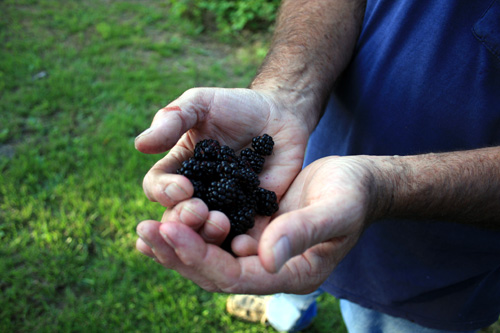
Home-cultivated blackberries from wild bushes.
(*photo credit)
November 12, 2010
What are Small-Scale Gardening Techniques?
Each of us develops a
certain cadre of techniques which are modifications on existing garden ideas.
Mine include:
Raised beds allow for
the excess water to drain off rapidly and permit me to cultivate soon after a
rain. Some people require mechanical tillers to do some of the hard work in the
spring. On the other hand, fashioning a raised bed takes a lot of initial human
physical labor, but regard it both as physical exercise and as an investment in
the future of the garden. In fact, gardening is a moderate physical exercise
using a variety of muscles; it is not repetitive like cycling or hiking. The
rising and bending and working of hands and back muscles are all part of growing
vegetables, herbs and flowers, all of which can be intermixed.
Mulching is important
for keeping down the weeds; once you are convinced, you will be happy to know
that extensive literature exists on types of mulch (plastic, leaves, sawdust,
straw, dry grass, etc.). I find that vegetative mulching with vine plants is
really the best, provided the peppers and tomatoes are not smothered by the more
aggressive varieties of cucumber or cantaloupe vines. Once we realize what the
spatial needs of a certain vegetable are, we can consider room for expansion at
a given plant location. We can place certain plants near paths or open lawn for
future expansion; with greater care we can allow the plant (zucchini near
certain herbs) to act as a vegetative cover for others. I like to plant peppers
amid cucumbers because the vine cover protects the peppers that grow straight up
and need little extra room in early summer.
Floral intermixing
gives color to the area, and at the same time marigolds and other flowers serve
to keep certain insects away. On the positive side, the presence of enticing
flowers will act as an attractant for butterflies and for pollinating insects
that are so crucial to all produce. Cosmos volunteer and return the following
year and give a special color from late June to autumn. Also insects and
butterflies like certain flowers.
Various salad greens
are needed, for the cost of fresh produce in most places mounts up, and the
greens' nutritional value is immense. A goal ought to be to introduce a variety
of salad tastes during the entire year, especially during the non-growing winter
months. Greens have other benefits; for instance, mustard borders serve as
barriers to roving rabbits.
Herb-growing
in small areas is worth considering, since fresh parsley or oregano are good for
spicing soups or other dishes. Many herbs can thrive in winter in pots, and
thus be moved from outdoors to indoors as the weather becomes colder.
An
answer: Gardening has many benefits when done on the small-scale level.
After we become convinced, we can go out to our non-growing neighbors and gently
prod them to garden as well.
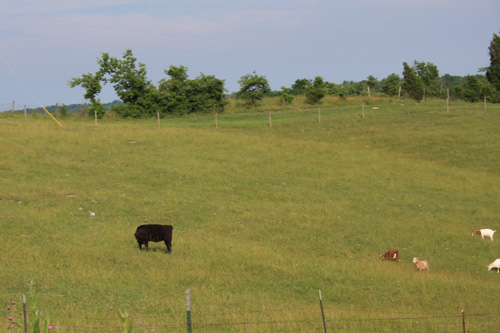
Livestock, grazing in pasture.
(*photo credit)
November 13, 2010
Should We Preserve Surplus Food?
In answering this question
we recall that preserving efforts can take time, require storage space, and may
not necessarily lead to a higher quality product -- especially if surpluses can
be distributed and consumed by the needy. Refrigeration replaced salt as the
major preserving agent about 1900. An ancient motivation for preserving was for
plentiful food during non-growing periods. Other obvious benefits include:
convenient food for a variety of winter menus; good budget strategy and a hedge
against food-price rises; emergency supplies at times of floods, violent storms,
or earthquakes; showcase of good housekeeping because open shelving delights
visitors; practice that prevents the wasting of food produced; and a reduction
in the number of grocery store trips.
How do we preserve surplus
brassicas, cucumbers, zucchini and tomatoes? Our foresighted ancestors thought
ahead to the non-growing colder season; they dried, salted, canned, stored in
root cellars, and left root crops in the ground. We imitate their
foresightedness through existing and new food preserving-techniques:
* Root Cellars are
long tested as a good place to store produce. These storage places are partly
or totally submerged outer buildings or interior space. They are dark and cool
places at constant temperature and controlled humidity, where produce can be
preserved during winter. Root cellars are good for potatoes, virtually all the
root crops, squash, pumpkins, brassicas, apples, pears, celery, and even
individually-wrapped tomatoes.
*
Canning fruits, berries and vegetables takes effort in the heat of
summer, but preserved food tastes great in winter and the contents are beautiful
to behold on storage shelves.
*
Solar drying is a low-priced excellent preserving-technique for low-moisture
produce such as carrots, onions and apples. In its own way, this technique has
been around a long time also.
Pickling
involves the ancient use of common salt; curing meat through the salting process
dates back to hams from Celtic lands transported to Roman overlords almost two
millennia ago. The salting or "pickling" process extends to cabbage
(sauerkraut), cucumbers, beets, peppers, and turnips as well as eggs.
Freezing produce is a
convenient food-preserving method, but generally uses non-renewable energy to
operate. Some products become leather-like through freezing without special
treatment, but the method works well for corn, peas, berries and many fruits.
Allowing crops to
winter in the soil is a simple preservation method in temperate areas. In
Kentucky, we can protect carrots, Japanese radishes, Jerusalem artichokes,
onions, and turnips.
An
answer: Yes, but be open to ways for better preserving.

November leaves on deciduous trees remain green only for a short time in
Kentucky.
(*photo credit)
November 14, 2010
Homily: Do We Know the Changing Seasons?
...When will this happen,
then, and what sign will there be that this is about to take place?
(Luke
21:7)
In this year 2010, many
people have become deniers of what is really happening, namely, the rapid
warming of our planet. Can't they look out and see hotter summer months that
seem to break a record each year, or hear of calving ice caps, or observe floods
and droughts and rising oceans? Some fearful people choose to deny that climate
change is of human causation, and prefer to regard this as an anomaly or quirk
of nature. They prefer to defend the status quo -- if there even is such a
thing. Today's Scripture readings have never been more pertinent than in this
year 2010.
Security in the Lord
involves a fear and also a trust. Our fears need to be
well-founded with acute observation; furthermore, we can do something about what
is happening. We are not fated to the inevitable; we can make our future in an
active way. The materialistically-concerned address insecurities by more
insurance, anti-ballistic missiles, wallets of cash, credit cards, college
degrees, locks, vehicles, full storage bins, alarm systems, and on and on. The
spiritually-concerned are equally fearful but sometimes address the conditions
through minimizing the changes or saying they result from natural causation.
They may affirm personal wrongdoing and group wrongdoing in the same breath.
No, we do sin and we make mistakes, and part of this is what we have
collectively done to our earthly environment.
If
this planet's age were a single year, Christ would come in the last moments. He
postpones his return out of mercy but it will be "soon." Let us prepare to meet
him. He assures us our past was imperfect; our future can be better; our
present must be our point of immediate focus. When havoc is pending and major
changes occur, people may retreat into a state of denial. They seek desperately
to grasp for some control on matters, to deny that changes really are happening
at such speed. Change never comes easily, for this takes a deepening
spirituality with a longer term outlook.
An authentic spirituality
calls us to thank God for the opportunity to serve the Almighty here and now.
We pray for the insight to see these times through keen observation and a
serenity of spirit. All of this calls us to ask the right questions and listen
for the response from wherever it will come. Remember, materialists are
distracted by glitzy things; those with false spiritualities may fixate on an
idealized past that did not really exist. Both sets are insecure, though
reacting differently. We ought to pray for a chance to have a more balanced
outlook on life.
Prayer of the week:
Lord, help us to give thanks for your gifts. One gift is to know the signs of
these times. In the urgency of the present moment, we beg you to keep us alert
and to help extend this sense of urgency to those who deny the signs that face
us all.
Introduction to 1990s: Food in
Excess: An Adult Problem
The
1990s, the final decade of the twentieth century, found me having a radically
different attitude about food. The decade was ending with a new outlook on the
world, as the USSR collapsed and the grip of Russia on fifteen other nations was
broken. The global capitalists were convinced they had triumphed -- and
everything, even food, was affected by the victory. The century had experienced
the Green Revolution, mechanized farm practices, corporate farming and
pesticides, and new types of genetic seeds, synthetic fertilizers, UN food
programs, storage facilities, giant cargo ships, and instant communications. We
could tackle hunger on a worldwide level, and profit-makers were poised to
benefit.
As
for my part, aging was resulting in a portly stature edging close to obesity.
My appetite was still as grand as ever, but the body no longer needed as much
food. Weight was starting to climb and instead of having the lowest weight
among my male siblings, I was moving to having the largest -- imperceptibly at
first. The moderate weight of the 1980s was now being stretched, and weight-
watching was a possible concern. My gut was the focus and I was not unique
either; I was joining the food-excessive American majority. The only comfort
was that various physicians said that, as we age, a little more weight is better
for warding off and recovering from the opportunistic illnesses that afflict our
age groups. Cold comfort, if we see that enhanced weight also has additional
health effects such as heart trouble and diabetes. We elders tend to focus on
high cholesterol, high blood pressure and high sugar levels -- along with higher
scale readings.
Exercise
yes, but it is hard enough to resolve to set time aside each day for the one
hour that is recommended. However, the will to allocate time is only part of
the problem; actually physical exercise can also trigger expanded appetite, more
eating, and more weight. This becomes a vicious circle, for the more we try to
take off, the more we gain in those extra helpings. Part of our weight-watching
must involve reducing caloric intake and eating more nutritious foods such as
more expensive fresh fruit.
Comfort
comes when we realize that we need less of the wholesome foods and thus smaller
purchases. Having said this, the lesson is hard for elders to learn, for we
like what we eat and habits are harder to change with age. We search about for
reasons that permit the status quo -- and what we like is hard to abandon.
Those of us who seek to be in solidarity with the poor realize that pastas,
beans, and cornbread cost less than fresh fruits, yogurt and most nuts -- and
yet add weight. Diet changes seem to make Lent a year-round season, but it also
brings self-control to the forefront. Change we must, and so the search for
good reasons goes on and on. Less weight makes us more mobile as well as puts
us on a better health track. We stay younger in looks and spirit.

Lattice atop fresh wild berry pie.
(*photo credit)
November 15, 2010
Is Food Always Tempting and Enticing?
Few
things increase girth in middle age faster than to give up smoking and/or
physical exercise. I gave up the first and modified the second over time. One
friend confided that he gave up smoking and immediately exploded by thirty
pounds in the same number of days; however, he began jogging daily and has
continued well into his eighties -- and he seems to be in good health as of this
writing. Elders cannot expect to remain in the same condition as in youth, but
it was difficult for me after forty-three years of jogging to give up that
beloved exercise. Burning off calories easily and the running "high"
experienced in jogging are missed. However, the body tells us something in new
backaches and wounded knees, though joggers realize there is no good substitute.
Moderation
in exercise and smoking cessation ought to allow for greater self-control. To
gain such control often makes food smell, taste, and look better -- that final
allurement for the weight-gain prone. In youth, when calories were being burned
at a rapid rate, we thought we would stay thin forever. Not so. In aging, we
are actually under less stress and the metabolism changes allowing weight to be
added and added, hardly ever subtracted. We have to acquire techniques that
give a sensation of fullness or keep our minds on other subjects.
Moderation in all things is
still a good principle in food-related matters, especially when the foods are
good and the portions are appropriate. However, appropriateness includes size
and frequency. Our thought is to satisfy the appetite, and our imaginations
suddenly see good foods crop up in many places; a thought occurs to go to the
food shelf or refrigerator one more time. Advertisements can allure us with
sights of good dishes; restaurants can beckon; friends can invite us to meals.
It was a shock for me to see that my 170-pound range of many decades turned to
the 200-plus-pound range. Middle age spread is a reality when you love to eat
good food.
There
are many ways of dieting and saying "no," but none come easily with respect to
food. Food issues become present and stay in importance triggering our brains
to call out for a little more. It is amazing that when we forget the names of
all but the closest of associates, we still can vividly recall the sights,
smells, and tastes of our favorite foods. Acquaintances are forgotten, unless
they are edible. Each food dish carries with it a concatenation of events and
warm feelings that rush back into vivid memory.
An
answer: For those of us with good appetites, food is always tempting except
when we are really sick. The better thing to do is get one's mind off the food
issue and concentrate on other desirable practices -- or to have a glass of
water. Remove oneself from ready access to food; limit eating times; regulate
snack food variety and availability; take smaller portions; refuse desserts or
just have a taste of the richer food; and eat less in the evening.

White-lined sphinx moth (Hyles lineata).
(*photo credit)
November 16, 2010
Must We Always Avoid Fatty Food?
Fat foods go to the gut and
storage places of human fat. I used to like to weigh myself after jogging, but
now the daily exercise is more difficult to endure even if the results must be
registered in the daybook. Fatty foods are part of the obesity problem in this
nation. The percentage of people weighing more than the obesity mark (depending
on personal size and body density) has risen in recent years from 15% to 20%,
and now to +25% of the total population in a number of states including
Kentucky. In 2010, in over half the American states, obesity rates have
increased. Causes are generally attributed to too much of the wrong food and
too little exercise. One could add other factors: lower smoking rates; more
sitting during the day; less walking and more driving; larger helpings and
increased size of restaurant servings.
People
who fit into the obese categories just mentioned ought to be doubly alerted.
Get the problem kids to become active again and forego the computer games.
Regard weight control as a total family problem, not just an individual's. Our
circuits are wired to like the smell of fast food, the mouth-watering
advertisements, the tastes of salt, fat, and sugar, and the prices that beckon
people to come and consume more and more. The result of being caught by excess
food includes obesity, diabetes and heart disease.
David
Kessler, former head of the Food and Drug Administration, writes and speaks
extensively of this barrage of food enticements that affect us all, especially
the role of advertising and the fast food places and large portions. We may
want our money's worth and thus we eat more at buffets. What was said about
companies inducing youth and others to smoke could be repeated with respect to
food; however, we have to eat and whether we eat is not a free choice to start
-- only how much we put on the plate. If we eat wholesome foods (fresh produce
and whole grains), we are less inclined to health problems. However, rules
vary.
The
food companies' strategy consists of increasing the processing of foods we
choose to eat. Their battle plan is to get people to direct their appetites to
the fat, sugar, and salt-laced materials that induce the desire to buy more and
more of the same candy and Big Macs and salted snacks. Instead of water as a
filler, the object is to promote soft drinks -- that carbonated sugar water with
flavorings that costs much even at bargain rates. The promotion by food
companies is partly to blame, not totally. We have to attend to their ads and
then we cave in -- "the serpent made me do it." Personal responsibility is at
the heart of weight-control, but that is not easily accepted at any age, young
or old.
An
answer: Fats are often regarded as food negatives -- but we need some fat
intake for balanced nutrition. It's not total abstaining nor unlimited intake.
The principle of moderation in all things applies here: know and control fat
consumption. Yes, labels on containers can be helpful; types of fat are
important, so prefer plant (olive or canola oil) to animal fats.

Oval ladies-tresses, Spiranthes ovalis.
(*photo credit)
November 17, 2010 Should
We Create Our Own Fast Foods?
Fast
foods may be a commercial aspect of our age but they have been around awhile.
In fact, throughout time people who needed to travel had foods that did not take
extensive preparation. Some kept beef strips under their saddles or made use of
dried fruit, or nuts, or "hardtack," or oatmeal or pickled foods. Eating on the
run has a long history, though today we have more options. Yes, we have snacks
and "gorp" and all sorts of frozen or prepared foods that compete with
hamburgers and fries in fast food places.
Busy
folks satisfy their hunger pangs in different ways: eating seated after
ordering in, taking food out to eat in the moving vehicle, preparing frozen
dinners from the deep freeze, and heating meals in the microwave, etc. We need
ideas, especially if we want to eat balanced meals, to refrain from prepared
foods heavily laden with salt, refined sugar, and animal fat, and to be economic
in time of belt-tightening. Possibilities exist:
Let spices work for the common meal -- Make enough of a dish for several
meals and do not limit eating these to once a day; however, so the same food
will vary in taste, change the herbs and spices with each new preparation.
Create
simple meals and desserts -- Learning to prepare attractive dishes does not
mean that they have to be exotic, for fresh fruits, herbs, and vegetables are
attractive in their simplicity. A mixture of watermelon and blackberries when
in season is good as a salad, lunch or dessert in the evening -- and can be
eaten throughout the week.
Select
simple snacks -- These snacks can be of a wide variety and could involve
fresh vegetables and fruit and nuts in contrast to potato chips and dip. Celery
and carrot sticks, or apples, or orange slices can substitute for expensive
prepared foods and reduce preparation time and clean up. Some people focus on
popcorn or peanuts; others prefer whole-grain snacks such as oatmeal or roasted
soybeans with dried fruit or nuts.
Consider
multi-tasking the cooking process -- Steam vegetables within the pot
of brown rice that is being cooked for about one hour. I use Swiss chard,
zucchini, carrots, collards, poke leaves, mustard, kale, peppers, radish greens,
apples, or beet greens.
Mix
fresh produce with leftovers -- A batch of chopped up materials from the
garden can enhance a day- or week-old soup or pasta dish. Enhancement can also
be ingredients from canned or frozen materials. Varying produce allows new
tastes and appearances, all needed for the spice of life.
An
answer: Pretending that we will take large amounts of time preparing
ordinary daily meals is unreasonable for busy people. It is far better to
accept that fast foods are part of our daily life and learn to cook in
efficient, tasty, and low-cost ways.

Connection.
(*photo credit)
November 18, 2010
What are Limits to Distributing Food Commodities?
Hungry
people need food, and commodities ought to be easily available for them. When
need arises, charity is required, but we often ask ourselves what are the
long-term effects on recipients of free food? Local food distribution problems
affect two different sorts of people: those who are reluctant to get the food
even when they need it out of personal respect and pride; and those who are
takers when they could earn their daily bread through other means. The first
group often have worked hard in life and through illness and old age are now
strapped for food. The second are those who clutter the distribution system and
give it a bad name.
The
first, once they have been persuaded to take from the food commons, will use the
handout wisely and not waste the materials given, nor choose junk food when
offered options. Just getting them into the food distribution network is
sometimes a chore but is well worth the effort. This group is usually most
happy to use the basic staples (grain or prepared flour or cornmeal), cooking
oil, canned or dried milk, and beans or equivalents; they will not complain, and
they prefer to prepare good meals from simple foods.
The
pushy takers are more difficult to address. The lazy or the ill-budgeted parts
of that category of cases find it hard to meet needs properly for themselves or
their families. These folks may be harmed by easy handouts and can become mere
professional beggars; they crowd out those who are more in need of food. Some
will go so far as to trade food items, food cash donations or unspecified food
cards for drugs. Generally food distributors are experienced and alerted to
this second category of people.
Granted
that the needy include inexperienced purchasers or growers, we ought to consider
their nutritional education. A certain freedom to purchase within a food stamp
program is allowed; this was practiced early in the food stamp program when Coca
Cola and other soft drink producers were strong proponents, even though some
like some of us spoke out against using food stamps for soft drinks. The
softer-hearted championed the needy's right to choice; harder hearts regarded
the taxpayers' right to see that food money was spent wisely.
Food
education exists for WIC (Women, Infants and Children), federal programs
operated through local health departments. Such education ought to be mandatory
for food stamp recipients, if a specifically restrictive food distribution
policy is not enforced. Such education should include making one's own baked
goods, herbal drinks, fixing bean and other non-meat protein materials using a
variety of spices and flavorings, preparing healthy snack foods, use of more
fruits and vegetables, and choices of meatless meals. The needy may prefer junk
foods to wholesome alternatives.
An
answer: Surplus food needs to be distributed to the hungry, but we must
strive to eliminate the hunger condition -- and to ensure that recipients learn
to earn their daily bread.

Billowy clouds overhead.
(*photo credit)
November 19, 2010
Is the Food Distribution System Fair?
Our
neighbors may be hungry and they certainly have a right to enough to eat -- a
right worth defending. Food riots have and will undoubtedly continue to occur
in poorer countries. America is not in such dire circumstances at this time,
but food shortages occur here as elsewhere. I serve an Appalachian county with
a 23% poverty rate and high drug use and overdosing. As one might expect, some
of our residents run low on food, especially at the end of each month.
Conventional food sources often run short of food supplies.
The
American government's (federal, state and local) food sources are generally
available. Our greatest source is food stamps that those with low
incomes can receive. The use of a personal coded card has reduced abuse of this
program. One of the difficulties is that these stamps can be used for a wide
variety of food and even soft drinks by people unfamiliar with cost and with
little understanding of the lack of nutritional balances resulting from
excessive junk food. A more specific government program is WIC (Women,
Infants and Children), which provides food, health care referrals and nutrition
education to low income pregnant, breast-feeding and post-partum women as well
as infants and children up to age five who are in nutritional need. A third
government distribution program (provided food surpluses are available) is the
federal commodities program that dispenses peanut butter, cheese, and
other nutritious commodities to those who qualify; this program often lacks
available food surpluses. Non-profit
organizations have sought to fill in the cracks.
Direct money handouts have
been discouraged and are not now a popular means due to misuse by those who
suffer from substance abuse. A better direct approach is the retail card
that is sold by various food supermarkets; these can be used by the recipient
with only slight restrictions depending on buyers' choices (and include gasoline
at associated fuel stations). Cards are open to misuse.
Garden
produce and other food surpluses such as wildlife from hunts are
available at various times of the year. Sharing these with people who are in
immediate need or who can preserve the surplus in some fashion is ideal for
reducing hunger. Unfortunately, this is quite seasonal and does not necessarily
mean that the surplus reaches those in greatest need. Second Harvest
programs are available in some places; these groups identify outlets for
slightly outdated and unsold perishable foods and collect and distribute these
materials to the homeless and lower income people. Again, the program depends
on hit-and-miss conditions. Meals-on-wheels distributes prepared dinners
to the sick and elderly. Churches and other institutions give food baskets at
Thanksgiving and Christmas. Finally, some organizations and networks gather
basic commodity surpluses for the needy.
An
answer: Local food systems can meet basic demands. However, the world's
hungry people are just beyond our back doors.

Remnants of the Kirkwood Pike covered bridge spanning the Salt River, Mercer
Co., KY.
(*photo credit)
November 20, 2010
Vegetarianism: Is It Good or Bad?
Nothing can elicit more
varied feelings than to say it is time the world went vegetarian. Some, such as
people from my German ancestry, regard "meal" and "meat" as almost synonymous.
However, when observing the abuses of chicken-raising factories and cattle
feedlots, we find that a vegetarian argument gains strength, even when not
convincing all. An emerging argument, based on resource intensity, focuses on
the amount of feed and resources required to produce a pound of beef or pork in
contrast to the amount used to produce the grain alone for feeding hungry
people. One compromise is to reduce meat consumption, but still allow the
special cultural meat preparations on festive occasions. A third argument may
involve reduction or elimination of meat consumption based on religious,
spiritual, or moral obligations.
Is
doctrinaire vegetarianism to be treated seriously at this time? The answer may
depend on the conditions or attitudes of vegetarians. Some of us eat LESS meat
and yet are not defined as vegetarian, for we find that meatlessness makes hosts
quite uncomfortable when cooking the traditional Thanksgiving meal next week.
Some primitive cultures especially in frigid regions of the Arctic do not have
vegetables in their diet, and so meat is an essential component of the total
diet. Other tribes and groups have had to supplement their diets especially in
the non-growing part of the temperate zones by eating wildlife such as deer,
rabbit, turkey and wild goose. In both cases, the need to respect what is
killed can be an integral part of the culture.
Human
beings can live solely on plants and/or animal products and thrive. We ought
not to condemn the either/or nor those who use the mix of plant and animal
products. However, the move to get people to shift diets to more plant products
is to be encouraged. In any country where vegetarian foods are easily
available, far fewer resource-intensive animal products will be demanded as a
greater part of the population goes that route. The green movement calls for a
shift to plant foods and many respond.
However,
we ought not to cast all our eggs into either the absolute animal-products
basket or that of the strict vegetarian's. Moderation is possible: eat animal
products when health or other necessities dictate, such as living in Arctic
regions or needing to supplement diets with wildlife. We ought to affirm those
who want to abstain from animal products, both for the sake of the fauna and for
their own sense of well-being and spiritual growth -- provided they are not
overly judgmental of non-vegetarians. The mishandling of livestock at factory
farms will lead to lower meat consumption and a promotion of vegetarianism with
long-term benefits to all but the meat industry.
An
answer: Vegetarianism, as a movement to reduce the use of
resource-intensive animal products, is good provided it does not become an
absolute doctrine. Jesus ate both lamb (Passover) and fish (post-Easter
gatherings). Let's continue to be festive.

Summer remnants.
(*photo credit)
November 21, 2010
Homily: Will We Choose a Throne or a Cross?
In
the end of the church year, we reaffirm our dedication to Christ the King, the
one who is crowned on a "royal" throne. However, on closer inspection we see
that this throne is actually an instrument of torture -- a cross for
crucifixion. Christ is Lord of lords, and yet he has redefined royalty through
servanthood that also involves suffering and death. His royal line from David
is not through kingly succession but in humble service.
Royalty takes a new form.
Pilate, a frightened Roman bureaucrat, who thinks he must appease the mobs,
questions Jesus about his royal line. Jesus speaks of being a king but not in
the sense that Pilate understands, rather of a throne which ends on the cross of
ignominy. While Hope Cook became a queen of Bhutan and Grace Kelly a Princess
of Monaco, still only a tiny number of the world's people can ever become
monarchs. Such chances fade for, while in 1900, 90% of the world's people lived
under monarchies; now, in the twenty-first century, less than 10% do so and the
number is falling. Royal thrones are few, but crosses, in this age of plenty,
multiply. We can't be royal monarchs but we can enter into the service of
sacrifice and thus share kingship with Christ.
In
1897 Queen Victoria of England (queen from 1837 to 1901 and empress of India
1876-1901) celebrated her diamond anniversary. On that occasion Rudyard Kipling
wrote a poem that angered many, who thought the Empire's lasting glory should be
unquestioned ....
The tumult and the
shouting dies,
The captains and
the kings depart,
Still stands thine
ancient sacrifice,
An humble and a
contrite heart.
Lord God of hosts
be with us yet,
Lest we forget,
lest we forget.
Those few who ascend royal
earthly thrones see them as fragile. Where is the Empress of India? A billion
would laugh at that idea today. Rather over two billion Christians are invited
to glory in the cross of Christ. Power rests here when storm clouds hang low
and lightning flashes and the earth trembles -- yet it takes faith to perceive
Jesus' power and glory where crowds cast dice and squabbled over his simple
garments. The cross is an instrument of suffering. How should a good God allow
this?
The Cross is a kingly
throne. We are being delivered into the kingdom of his beloved Son -- the
image of the invisible God, the firstborn of all creation.... in him all things
hold together (Col. 1: 12-20). The contrast of earthly majestic throne and
rugged cross is astounding, and yet it is part of the unfolding mystery, which
we are asked to contemplate on this great day. The entire creation is held
together through the cross, not by earthly power. Will we each choose a cross
and make it our throne?
Prayer:
Lord, help us see what the cross means in our lives.
Introduction to 2000s:
Food as Gift Worth Sharing: The Elder's View
Attitudes
change as individuals mature and modify their social networks. We move about;
we gain friends; we take up gardening; we find new sources of food; we discover
that our food tastes change with time. We entered the twenty-first century
hoping to eliminate hunger and then suddenly we were confronted with 9-11. Our
common goals were set back, and we even disagree as to how to handle terrorism
and a major recession. Bankruptcy looms just beyond the horizon; financing
social welfare emerges as a long-term problem; the differences between rich and
poor grow ever greater.
Failure
to share resources within, or controlled by, wealthier nations leads to a steady
undercurrent of discontent. The rich are targeted and even hated by some who
regard them as influencing one's culture through materialistic movies, fashions
and means of communication. When unemployed and with little future, low-income
youth regard terrorism as an option. A feeling of insecurity pervades people
who see no way out of their condition. Both socially and economically we are
confronted -- and food enters into this emerging picture in several ways.
Use
of food-producing land as a biofuel source for those with luxury vehicles is
emerging as a global irritant. Prices of staple corn and sugar cane food
products rise. This leads to some having sufficient food supplies but others
starting to cut back on the amounts they can acquire to feed hungry families.
Furthermore, the affluence of some makes them insensitive to the plight of the
hungry who suffer as victims of a form of terrorism. The first decade of the
twenty-first century has seen increases, not expected decreases, in the
absolute numbers in poverty and hunger (about one hundred million additional
people in these unfortunate conditions).
When
wealthy nations suffer from budget fatigue and hear of shortcomings in direct
food aid, they feel justified in cutting off assistance. An authentic message
to transform the focus of aid, from food packages to helping small farmers meet
local needs, is in order. Fair distribution of food means not handing out more
and more CARE packages, but a systematic advance in the food-growing potential
of every region of the world. However, to upgrade eroded and depleted lands to
full productivity requires resources such as farm training, better seeds,
fertility testing, and proper fertilizer, and better tools for cultivation and
harvesting. This change in aid will require a new Marshall Plan.
Our
twenty-first century attitudinal change must include the comfort of radical
sharing and the discomfort of neglecting to do so. Our food assistance goes
beyond the local level; it is rapidly becoming a global demand embracing all
people. Sharing must leave the volunteer level and become a requirement, in
which all have a duty to give from their surplus -- and to see this as a mark of
global security. Our family in need is a global one; our attitude about food is
a compassionate one.
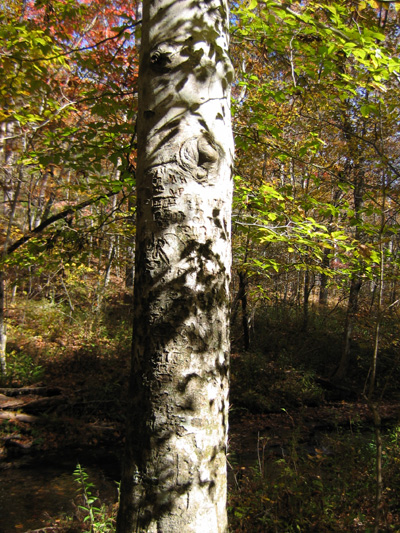
American beech, Fagus grandifolia.
(*photo credit)
November 22, 2010
How Do We Celebrate Food as Bounty?
Waving grain fields,
overflowing storage bins, endless supermarket shelves stuffed with thousands of
different food items. The picture seems soothing but it is incomplete. In the
distance is the irritating whimper of hungry infants or the silence of those who
are near death, or empty bins and drought-stricken fields. This age of
contrasts is as near as a computer switch and as far away as a mind bent on
escaping through a variety of distractions.
Bounty
is a good picture; the lack of bounty is stark. When we prepare a Thanksgiving
celebration this week we ought to see how bountiful food triggers an attitude of
profound gratitude. In fact, as we mature we think back at taking things for
granted and forgetting to say thanks for things received after parental
sacrifice and hard work. Those who look back with a sense of achievement and
happiness always fill their hearts with gratitude, the last service they render
before a happy death.
Thanksgiving Day is every
day, and this ought to be a cultural policy -- not a once-a-year national
observance. At this time we give thanks for the many gifts given to our land:
its resources, its beauty, its spaciousness, its creative people, etc. In fact,
our thanksgiving list ought to continue to grow (see Special Issues). Our
Thanksgiving holiday is not just a weekend or a Thursday each November, but
rather it is an ongoing celebration brightening the way we live our lives. We
learn from thankful people in their last years that they have much to "pray for"
in their last great ministry, but these are beyond prayers of petition and
begging and include thanksgiving -- for, if we end life with a thanks on our
lips, a merciful God will surely overlook our imperfections and accept us into
eternal life.
The food crisis has multiple
causes: droughts and floods caused by climate change; enhanced demand for food
by China, India, and emerging middle class countries; higher fuel and fertilizer
costs discouraging farmers from food production; conversion of grain-growing
cropland to parking lots, roads, businesses and recreational areas; conversion
of corn and sugar to biofuels; and reluctance of grain-exporting lands to allow
sales abroad. What can we do? Our soggy bowl of breakfast cereal cannot be
shipped to another land or hardly next door. But can we take some constructive
steps to alleviate food shortages?
An answer: Thank God
today by answering in some best-suited manner: serve in a soup kitchen on
Thanksgiving; donate food surplus to the local food bank; assist those who are
caregivers; report cases of food needs; say prayers before -- and possibly at
least quietly -- after each meal or snack; share food surpluses; thank the
cook(s); show courtesy and tip those who serve in restaurants; make national
representatives aware of the need for food assistance and storage for drought
victims; and consider a good expanded garden, assist a neighbor to start
gardening, or plan an edible landscape.

Autumn leaves collect in broken well along the Natchez Trace.
(*photo credit)
November 23, 2010
Can Food Be Designed as a Powerful Weapon?
It
was Joseph, as the man in authority in the country, who sold the grain to all
comers. (Genesis 42:6)
Perhaps
those in authority such as parents and camp directors know that withholding
desired food from someone has a way of changing behavior. "No ice cream tonight
unless ... " and then the demands to which the underling is expected to conform
are made. Often food has been used as a weapon or threat in order to change
conduct. Down through history this was not just a story for those who are
unruly toddlers or youth; unfortunately, the power of withholding food from
adult populations could have the effect of bending servant practice or feudal
subjects (e.g., the biblical story of Joseph and his family). We learn fast to
treat pets in a similar fashion. Conformed practice of jumping hoops is closely
related to food largess and rewards.
Using food as a weapon is
quite unjust when it comes to the needy, for it can be such a powerful weapon.
Placards carried by beggars at signal lights occasionally disturb us with, "Will
work for food." We know that during the Great Depression this was a practice
for those with empty stomachs -- the willingness to work for full meals. Hungry
people can be quickly reduced to dramatic requests for a meal. But they need a
living wage that consists of more than a day's food. What these begging
instances tell us is that donating food can be a strong means of getting one's
way. The right to livelihood takes precedence over the right to possess food.
In
a world of scarcity, food means power. Such a weapon of giving or withholding
food is cruel for it makes people subservient and reduces them to groveling,
which destroys their human dignity. Such differences threaten and disturb the
social order. A world of the super-rich and the destitute knows the power of
withholding food. However, all parties -- the hungry and the withholder of food
-- are hurt when some withhold and others go hungry. Certainly, the poor and
hungry are quite aware when praying the "Our Father," where we ask for our daily
bread. Here the well-fed may latch onto other interpretations of that prayer
that do not deal with the "our" being the entire family of human beings. The
well-fed often distance themselves from the hungry, but by coming closer the
prayer takes on new meaning. Some sated with food bounty have no concept of
this physical hunger and thus distance themselves from needs in an insensitivity
that condemns them. The poor must recall to the well-fed, that their own
salvation depends on their ability to share the food commons.
An
answer: Social justice must grow upon each of us, and it makes us refrain
from ever using food as a weapon. The hungry who have a basic right to food
should never come under our power to withhold what is essential to their
livelihood. They have a right to this food.

Fresh mulberry from summertime.
(*photo credit)
November 24, 2010
How Do We Share Food with the Hungry?
Shall be like the
hungry man who dreams he eats,
and wakes up with an
empty belly. (Isaiah 29:8)
We need to see that people
are the world's great treasure, and any time people suffer, we as part of the
human family suffer as well. We may be inclined to focus attention on the
healthy who are enjoying their days and making a sleek appearance in the world
around us. We may want to turn away from the hungry for it is hard to gaze on
the gray-faced ill or, for that matter, on pictures of extended bellies and
gaunt expressions of hungry children somewhere in the world. However, authentic
spirituality demands that we become aware of the true condition of our extended
human family, not just blood kinfolks. We ought to look about and see reality.
Like
the apostle Paul, we see the road ahead to glory and that sets us on a right
track that can overcome our depression and make us hopeful. The haunting
problems we have today can be overcome with God's grace promised from of old and
our efforts, which need to be ever renewed. Through faith we believe that we
have the right formula, and that we have been empowered by the Holy Spirit. We
have a course laid out for us, a treasure that we find and focus on diligently
in order to secure fully the ends towards which we were created. That treasure
includes the millions of hungry souls who are in need of essentials of life to
which they are entitled.
Directing
attention is more than merely taking time to focus at a given moment; we must
have the proper goal in mind. In fact, we learn much from clever business
people who are most diligent in pursuing their own ends of operating a
successful capitalistic enterprise. They teach us a single-mindedness to cut
out distractions and direct attention to specific goals. Do we have such goals
with respect to the poor? Are we distressed by the horror of pictures of
poverty in its cruelest manifestations? Are we resolved to help where possible?
Do we seek the face of Christ coming up to us from each magnificent creature?
Answers:
*
Discern what we can do through prayerful listening;
* Know and become involved
in local hunger issues;
* Read and gather
information on global hunger;
*
Champion the world food commons;
* Pressure elected officials
to expand food assistance;
* Reduce meat consumption
and use of prepared foods;
* Consider working at a food
kitchen or distribution center;
* Realize that food bounty needs to be shared
with others;
* Support rice bowl efforts
and "Bread for the World;"
* Challenge personal or
corporate food waste policies;
* Publicize the global food
hunger issue in any way possible;
* Make food shortages a
Twitter and Facebook issue;
* Resolve to expand the
garden, if possible;
* Give away garden
surpluses; and
* Encourage neighbors to do
the same.

Homemade ice cream.
(*photo credit)
November 25, 2010 Do We
Thank God Enough for Gifts of Food?
Each
day, week, month and year we ought to give special thanks. Of course,
Thanksgiving Day is our grand "thank you" time for --
Awareness of others in
need;
Creative ways of helping
them;
Availability of food at
our table;
Safeguarding of food by
regulatory agencies;
Purity of food that we
buy;
Supply of land on which
to grow food;
Refrigeration;
Preservation and storage
of food;
Dependable transport of
food to where needed;
Relatively low priced
groceries; and
Proper distribution of
food to those who are hungry.
Part of the American
Thanksgiving story is that the Indians assisted the first English settlers at
Plymouth in Massachusetts Bay in growing corn by fertilizing each hill with
pieces of fish. Though this may be a myth, still the history of settlement of
this land has involved Native American food-growing experience being generously
passed on to newcomers. These natives showed generosity to their neighbor
because that was their culture of hospitality.
On
Thanksgiving Day, food takes on a special meaning. For through eating food we
are reminded of the community of people struggling and surviving by the largess
of others. We thank God for seeing that sharing is a blessing for us and
others. The resulting meal is really America's special cultural feast, namely,
turkey, corn pudding, cranberry sauce, and pumpkin pie -- all foods from the
North American continent. Other side dishes and other meats may blend with that
tradition within cultural roots.
Turkey
is a key to this day, and it challenges vegetarian practice to abstain on
Thanksgiving Day. Substitutes seem to pale and turkey may be an argument for
being occasional meat-eaters and not total abstainers. However, that will be a
decision on the part of practitioners that one should not tinker with during
this season of thankful bounty.
Today
our part of the county has an overabundance of "wild" turkeys. Amazingly, this
stocking of game by hunting agencies has a side effect, for the "wild" turkey is
heavily crossed with domestic varieties, and thus the offspring is a heavier and
more enticing game animal than the original wild turkey. However, these modern
wild turkeys are like tractors clawing their way across the fragile, woodland
understory. In fact, ginseng seed is threatened by the manner in which it is
devoured and crushed by the these efficient fowl. The overpopulated of turkeys
is a problem worth addressing, and harvesting some at Thanksgiving time is
fitting.
An
answer: We never thank God enough for the many gifts we have received.
Let's make this a thankful day.

A loyal friend.
(*photo credit)
November 26, 2010
Ought We to Have A Global Food-Sharing Program?
...To share your food
with the hungry.. (Isaiah 58:7)
Thanksgiving
season is a perfect time to extend our outlook beyond our homes and local
communities to a world of hungry people. The less fortunate would feast on
Thanksgiving table leftovers. The food wasted each year in affluent nations is
sufficient to feed the world's hungry. However, table leftovers in themselves
can hardly be shared because of spoilage in shipment. If bulk foods such as
grain, root crops, and oil were not "prepared" but shipped for storage at key
places, these could be trans-shipped to points of need when people suffer from
floods, hurricanes or droughts. Sharing globally is a moral issue and wasting
food is immoral. Climate change and distorted markets are making this a
compelling issue. The Economist, September 11, 2010 (p.20), suggests
that food markets must adjust because of the growing volatility of food prices
and the vulnerability of the poor who can't afford these spiking price rises
(riots in 30 countries in the past two years).
First,
agricultural protectionism by wealthier countries should be reduced. Second,
food trade must have some insurance against export bans (a great stumbling block
of the World Trade Organization); the 2010 Russian ban has contributed to a food
price spike even though globally this year will have one of the largest wheat
harvests on record. Lastly, the world would greatly benefit from a Global
Emergency Food Storage System. John Maynard Keynes suggested this six
decades ago, and it is still a long way off. Maybe the World Food Program could
run seaport depots in vulnerable areas: the horn of Africa, west Africa, south
central Asia, southeast Asia, and the Caribbean, for starters. Storage systems
could be protected from rodents and restocked after the life expectancy of food
has expired, with outdated food distributed in a manner not to disturb local
food systems. Often bulk grains processed into noodles or other pasta can be
preserved longer.
Reduction
of wastes can occur on either end of the food production/consumption chain:
growing, processing, transporting, and selling is one part; buying, cooking,
reusing leftovers, and preserving is at the other end. Harvesting could be open
for gleaning. At the consumption end, grocery stores often throw out outdated
animal products and baked goods; and these could be sold at reduced rates or
given to food distribution centers. Local food laws related to reuse of food
are often over-restrictive and ought to be amended so that Second Harvest
and soup kitchens can use leftovers. Oversized restaurant portions often go
uneaten. Furthermore, buffet operations result in large amounts of waste by
consumers who take far more than they can eat. What about penalties for wasting
food? Some concerned folks will over-scold for wasting, and others neglect to
challenge the practice
An
answer: We need to improve our awareness of food waste and learn to share
at a global level. Both individual practices and governmental coordination are
needed to help share food better.

Autumn field against vivid blue sky.
(*photo credit)
November 27, 2010 Is Food
Sharing a Component of Final Judgment?
For I was hungry and you
(never) gave me food.
(Matthew 25:35 or 42)
Food enters into every
aspect of our life. As we age, we confront the fact that all mortal life is
terminal (not eternal life); no amount of food in quality or quantity will
change that fact. Loved ones pass on, but we hesitate to say that they die.
Some ill people linger, and some pass quickly, and some move on violently when
least expecting it. The judgment seat looms just beyond the horizon for some,
and is never in the thought of others. Do we hear Jesus speaking to us and is
it food-related? He is pressing us about feeding or neglecting to feed himself
when he was hungry. What is our practice of sharing what we have in abundance?
Do we extend our individual sharing with that of responsible sharing by entire
communities and a nation and a world?
Food
issues can enter into our exercise of citizenship. How do we tolerate one
thousand billionaires and one billion people without the means of food this
evening? If the resources were properly divided, wouldn't this feed a world?
The verb "allow" is what bothers me most. How can some have the power to hold
or to withhold resources, and some be so powerless? Why do I bother about
proper food distribution in our world when I can do so little about it? How can
I take on a citizen's responsibility and help make the food commons a reality?
Will we citizens who have a certain responsibility to pressure our legislative
representatives be held accountable for not doing so? Can we enter into a
mother's experience of no food for the morrow, hunger's form of terrorism?
Christians
regard Christ as King who will judge each of us on our own merits and demerits.
The reality comes ever closer as we age; the time shortens inevitably with each
passing day. No out- of-sight, out-of-mind for those who see visions. We have
our individual feelings about this most certain event; only the uncertainty is
when -- not if. Are we brave enough to be stoic about what is coming? Better,
are we wise enough to start preparing for the final days? Is our sense of civic
responsibility growing with respect to human needs? Does our silence as
citizens speak volumes -- and that deals with our upcoming accounting? Is it
wrong to ask all these questions in a world seeking daily answers -- as though
to reflect is to answer?
Nothing
focuses attention more than definite events in the near offing. As we age each
day, we hear the clock ticking away but it could be a promise, not a dreaded
happening. We are people pressing forward to a definite future that can be one
of untold happiness -- provided we prepare well at the present time. And
preparation includes sharing food with others.
An
answer: Advent always looms and involves an awareness that we will ask a
final question, and thus we need to prepare for it. When did I feed you, Lord?

Fleeting butterfly on patch of aster.
(*photo credit)
November 28, 2010
Homily: When Do We Wait and When Not Wait?
These will hammer their
swords into ploughshares, their spears into sickles. (Isaiah 2:4)
We attempt to wait
patiently in many places -- a doctor's office, an airport, a food line, a
bureaucrat's office, or at home waiting for a young person's return from a war
zone. Waiting for what is promised has a certain spiritual value as is
evidenced in the many words of Scriptures. If you are like me and in a hurry,
waiting is a terrible experience. In fact, as I wait I mull over the
ambivalence in the act itself: are there times when waiting is best and we can
do little else? Are there times when waiting is to enhance a status quo that
actually should not be tolerated? Do we await a New Heaven and a New Earth, and
even hasten this event?
Waiting could be interpreted
as being dutifully contented in the present state of world affairs, or it could
mean far more -- a holy discontent with these affairs and our own inaction.
Yes, it takes patience to tolerate the imperfections of our own unsuccessful
efforts. Patience involves realizing our own imperfections and improving our
performance in an orderly fashion. Patience is not sitting but acting with
deliberation and openness to improvement. "If the prize is big enough, it is
worth waiting for" becomes ...it is worth fighting for." Waiting becomes a
preparation for the coming of the one expected, putting in order and not messing
up the place. We hasten the coming of the Lord, and do so through godly conduct
(I Thessalonians 3:123-4:2).
You must wake up now;
our salvation is ever nearer than when we were converted (Romans 13:11).
Being watchful and waiting require keener observers. The truth is, watchful
waiting involves a little of all -- not expecting specific things as rewards,
not being so overly taken up with activity that we fail to reflect, and being
busy but not too busy at this time. Jesus calls us to be vigilant at all times
and to discover opportunities to help build a New Heaven and New Earth. The
time is short. We learn from geology that the Earth is about four billion years
old, and that in geological time the human race has appeared and flourished in
the last few seconds of that time. The grand act of human salvation has
occurred in the final second of the Earth's existence -- truly the end of time.
Be vigilant at all times.
The gospel writer (Matt. 24:37-44) tells us to be always alert. We do not know
the day or hour, and so vigilance is also before the Christian. We need to be
alert, and to encourage others to this state of readiness. Jesus is our
salvation; he leads the way, and he invites us to be not mere bystanders but
active participants in making a New Heaven and New Earth. Our weariness makes
us prone to fall asleep but, if we try, we can stay on guard and be the
watchdogs of the coming age.
Prayer
of the week: Lord, keep us alert through healthy living habits, and allow
us to foster patience in our vigilance.
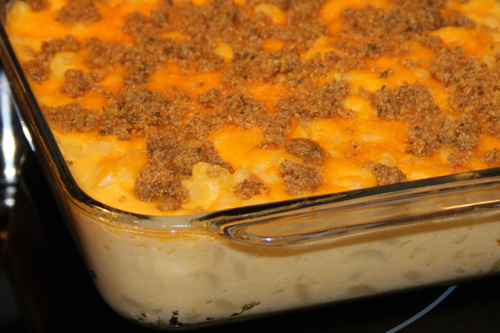
Fond memories of a recent Thanksgiving meal.
(*photo credit)
November 29, 2010
Food Consciousness Grows
Although
my food habits may differ from yours due to taste, culture, economic status or
even location, still we do have similarities worth comparing. As infants we
took food for granted. Our tastes changed when abandoning baby food for the
tasty stuff, and choices broadened. As we reached adulthood, we discovered that
food attitudes involve sharing with others. We learned to celebrate with food.
As our civic responsibility grew, our food attitudes took on a political flavor
involving governmental regulation of safety and commercial practices. We
decided to control food sources through gardening and harvesting and new buying
practices. As we moved past middle age, we needed less food and soon become
more watchful of both quality and quantity. Lastly, in elder years we prepare
to meet our Maker and think seriously about how our sharing with others, or the
lack thereof, will be judged in some way.
Many
conditions influence our attitudes about food:
* Growing
environmental awareness leads us to eat less resource-intensive animal
products and prepared foods and eat seasonally to conserve energy needed for
transportation.
*
Personal food choices give us a better understanding of the type and
quality of food consumed. Our food choices include greater emphasis on fresh
fruits, vegetables, nuts and whole grains and a de-emphasis on processed food,
sweetened carbonated drinks, refined sugar, animal fats, and salted snacks. We
think about control of weight, cholesterol, blood sugar, and girth.
*
Our public interest approach makes us see beyond self and the local scene
to a more global view of food needs, especially among lower-income folks.
* Our enhanced
gardening techniques include raised beds, living mulch, interspersed
cultivated flowers, spacing and location of vines and garden varieties, an
emphasis on salad greens and herbs, natural pest control and organic gardening,
and seasonal extenders for fall and spring.
* Regional health
problems with smoking, alcohol, obesity and associated illnesses and misuse
of over-the-counter drugs exist. Food safety becomes a regional problems
involving proper labeling, and awareness of food sources.
* Political and civic
involvement with elected legislators must be encouraged. Those targeted are
people willing to press for global food aid and who understand that subsidies in
converting food to biofuels raise food prices for the poor.
* Climate change effects
will very soon change the economic costs of food, the traditional areas of food
production and the weather patterns needed for food crops (see tomorrow).

A Kentucky autumn scene.
(*photo credit)
November 30, 2010
China, Food and Climate Change
A great disappointment in
the first decade of the twenty-first century has been the lack of proper food
distribution. Hunger was not alleviated during this ten-year period but instead
grew by a hundred million people. The rise of hundreds of millions of Asians
from poverty to a middle class society, with double digit resource increases per
year, has been the twenty-first century phenomenon; the emerging middle class
adjusted their diets too. China is number one in manufacturing, auto purchases,
railroad and urban construction, and in energy consumption (2.252 billion tons
per year versus United States' 2.176 billion tons in 2010). In fact, according
to the International Energy Agency, China has become first in energy
consumption five years ahead of schedule.
With
the rise of 1.3 billion people in China alone (with Asia and Latin America
following close behind) one finds several additional food-related problems. The
rising middle class can afford foods that are resource intensive such as meat
and prepared meals. Grain-growing areas even in China are being converted to
more profitable specialty crops. Furthermore, corn and other grains, sugars,
and cooking oils are being converted into biofuels, which adds to the growing
shortage of foods. Subsidies given to American and European farmers have
discouraged farmers in Africa from growing competing crops. Furthermore, the
weather does not always cooperate, and droughts help reduce total food
production for a given year. Certainly, higher food prices mean that the poor
have less food.
Where
does global warming fit into the picture? To be sure, the northern temperate
zone is extending further north in Canada and Russia, and especially Siberia.
With possible erratic weather associated with global warming, some areas in
Africa and Asia and elsewhere could become drier or wetter. Already the deserts
have been extending in northern China by a million acres a year, although
hopefully this can be stopped through reforestation and protective grass cover.
Global warming could cause African desertification in such poor countries as
Niger, Chad and Mali, and these nations can ill afford further surrender of
pasturelands to desert. Our American southeast may become drier also. When
possible droughts hit the major food-producing regions such as the American or
Canadian Midwest, Australia or Argentina, food shortages will be exacerbated.
In times of shortages, drought results in a ripple effect with richer food
importers taking in more of the scarce commodities and poorer folks being
squeezed.
If
icecaps continue to melt and oceans rise by inches or feet, one can expect
entire island nations to be submerged. Such nations as the Maldives, Fiji, and
several other ocean nations are quite understandably alarmed. Likewise change
in rivers that supply water for India, Bangladesh and other Asian lands could
affect crop yields. We cannot be like ostriches with our heads in the sand.
All citizens will be affected in some way, as we all observe rising food prices
becoming a central citizen and global issue.
|